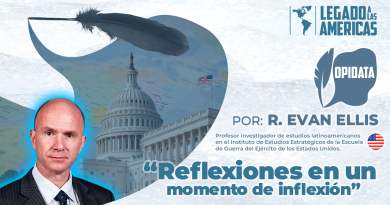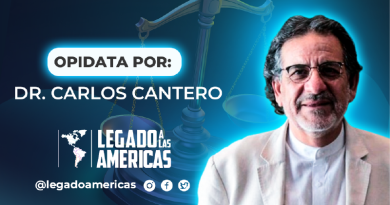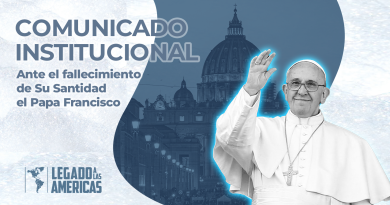U.S. Strategic Opportunity and Risk with Bolivia
✍️By R. Evan Ellis[1]
«Bolivia’s political future could redefine the balance of power in South America, expanding the Pro-U.S. bloc and limiting the influence of China, Russia & Iran.»
Introduction
On October 19, 2025, Bolivians will vote in the second round of their Presidential Elections, choosing between Rodrigo Paz Pereira and Jorge “Tuto” Quiroga. Following two decades of almost uninterrupted dominance of Bolivian politics by the left-oriented Movement Toward Socialism (MAS) party, the new political terrain into which the country is moving is transformational, albeit little understood and widely misperceived in the U.S.
Both Bolivian candidates have made commitments to working more closely with the U.S., Western Institutions and market principles of economic management.
Tuto Quiroga has promised to turn to the International Monetary Fund (IMF) and World Bank (WB), as well as de facto privatization of many government-controlled industries, expanding lithium production and exports to both the U,S, and Asia, to help the country weather its current crisis involving a lack of dollars from declining oil production, corresponding shortages of goods, inflation and economic contraction. For Quiroga, even an early resumption of U.S.-Bolivia counter-drug cooperation (a political taboo among the Bolivian left since Evo Morales expelled the U.S. Drug Enforcement Administration (DEA) from the country in 2008), could be on the table
Rodrigo Paz, in his discourse, has suggested a more cautious, centrist path around the slogan “capitalism for all,” focusing on reducing government expenditures and decentralization of Bolivia’s enormously inefficient, often corrupt system in which most resources and decisions flow through La Paz. He has promised to end Bolivia’s longstanding, expensive subsidy on gasoline, but not touching a wide array of social programs on which Bolivia’s poorer population has come to depend.
Although Paz’s father, prior Bolivian President Jaime Paz Zamora, was a founding member of the country’s Left Revolutionary Movement (MIR), with complex ties to Communism and Fidel Castro, son Rodrigo Paz was educated in, and spent his early professional career working in the U.S. and is regarded by key persons close to him to have a sincere pro-U.S. orientation.
Paz is also likely to bring a particularly charismatic style to the Presidency, with a proven capability of connecting with the country’s indigenous populations, particularly those of Amayra descent. Indeed, Paz spent a significant portion of his campaign logging hundreds of thousands of miles in commercial transport, including public busses and even a motorcycle, going from small town to small town, mostly in Amayra-populated parts of Bolivia’s Altiplano, to connect with local communities.
Paz’ running-mate Edman Lara, is also likely to shape the tone and policy direction of a Pa presidency. Lara is an outspoken, but politically inexperienced, anti-corruption crusader with an enormous Tik Toc following, selected by Paz at the last minute as his running mate. Lara, a former policeman fired for his criticisms against the deep corruption of that institution, has promised significant reforms to that institution and has quipped that he would even arrest Paz if the President becomes corrupted. Some in Bolivia worry that Lara could emerge as a driver of a new populist authoritarianism in the country, although others see such concerns as an attempt by those aligned with Quiroga to leverage fears of the left to discredit Paz. Whatever the reality, a campaign against could emerge as the hallmark of a Paz presidency, although Paz himself has been accused of graft while mayor of the capital city of his home Department of Tarija.
Both candidates have visited Washington D.C. in recent weeks and have reportedly had unofficial meetings with senior persons close to the current U.S. administration. The campaign is thus afoot by both campaigns to convince Washington that each is a reliable, friendly partner that the Administration can work with.
Strategic Implications
The strategic implications of both Bolivia’s new political direction, and the risk of the new government’s failure, are enormous. From the perspective of U.S. companies, Bolivia is home to the world’s largest reserves of lithium, as well as enormous quantities of other mineral resources and petroleum. It is also one of the countries in South America in which the People’s Republic of China (PRC) has built most significant ties, from the lithium sector, to infrastructure, telecommunications, defense and space cooperation, among others. Russia and Iran have also established a foothold in the country during almost 20 years of the populist left MAS governments of Evo Morales and Luis Arce.
The political environment in Bolivia is already changing. Judicial officials have released from jail the former conservative governor of Santa Cruz Luis Camacho, and reportedly may release jailed former conservative transitional President Jeneane Anez, among others. A number of high-level right-of-center figures, no longer fearing being detained and imprisoned on trumped up charges, are cautiously returning to the country to pursue political and business initiatives in the new environment.
Washington should anticipate the likely dynamics of, and prepare engagement strategies for both a Quiroga presidency, and a Paz presidency. Current calculations in Washington that Quiroga will win, based on his formal 8-point lead in the polls, are premature. Polls in Bolivia have historically underestimated the vote for the candidate on the left, due to reluctance of those polled to admit a left voting intention. The distortion of results is compounded by pollsters having less access to the most marginalized urban neighborhoods where residents tend to vote more for left-leaning candidates. Indeed, pollsters mostly missed the enormous surge of votes for Paz in the week leading up to the first round of Bolivia’s election. The actual vote that Paz received in round one, 32% of those voting, (versus 27% for Quiroga), should be taken at least as seriously as the lead for Quiroga shown in the latest polls.
From a strategic, regional perspective, the likely willingness of either Quiroga or Paz as President to work more closely with the U.S. on a range of economic and policy issues, will further expand the U.S.-friendly block roughly spanning the western portion of South America. Although the nature of each partner’s relationship with the U.S., and with the PRC varies, Bolivia would join Argentina, Paraguay, Ecuador, and possibly Peru (whose President was just ousted on October 10th), in that group. Further contributing to the pattern, in November 2025, Jose Antonio Kast will likely beat Communist candidate Jeanette Jara in the second round of Chile’s Presidential election.
On the other hand, on the eastern side of South America, relations are significantly strained with the Leftist Lula government in Brazil, the Petro government in Colombia, and the Maduro regime in Venezuela (absent military action which precipitates a change in government there). On the other hand, a positive experience with a more U.S. and market-friendly government in Bolivia could also influence upcoming elections in Peru in April 2026, and in Colombia in May 2026, in favor of the right, further advancing U.S. strategic interests in the region and limiting those of the PRC, Russia and Iran.
The Path Forward
With respect to Bolivia, whoever wins on October 19th, the U.S. should be prepared to support an aggressive IMF package, and to give a strong signal of U.S. financial support as it did with the Javier Milei regime in Argentina. Doing so will be critical to restrain Bolivia’s downward financial and economic spiral, and to insulate the new Bolivian government from likely attempts to destabilize it that may come from the radicalized portion of the left.
Based on the results of Round 1 of the elections on August 17, the center and right of Bolivia’s political spectrum will hold more than two-thirds of the seats in the country’s bi-cameral legislature. That will give whichever candidate wins a window of opportunity to implement their legislative agenda. If Quiroga wins, as noted previously, he will likely be disposed to move more aggressively on engaging with the IMF and implementing needed economic reforms, although to do so, he will likely have to mend fences among the supporters of the other right-wing candidates Manfred Reyes Villa and Samuel Doria Medina, against whom his campaign made some deeply divisive and personal attacks.
If Paz wins, he is likely to move more cautiously and may feel less latitude among his coalition to implement the radical changes required to address Bolivia’s economic crisis, although senior Bolivians consulted for this work believe that Paz will ultimately need to work with the IMF as well.
Paz, despite his U.S. education, professional experience and pro-U.S. orientation, may also be more cautious in fully aligning Bolivia aggressively with U.S. foreign policy. Particularly because of Paz’ own ties with the U.S., a shift to align with the policies and requests of the U.S. that was seen as too abrupt and unquestioning, could provide more impetus for centrist members of his coalition to become disillusioned, and the Bolivian left to rally against him, similar to what occurred with transitional Bolivian President Jeneane Anez in 2020.
The likely campaign against corruption by a Paz administration, probably spearheaded by his Vice-President Lara, as noted previously, will also create challenges, along with opportunities, for a Paz administration. A meaningful attempt to clean up Bolivia’s profoundly corrupt institutions would likely prompt a counterattack from elites threatened by such a campaign. Such a counterattack might include votes, criminal charges or other actions against Paz and his ministers, leveraging legislative and judicial institutions that the threatened elites control, as well as weaponization of discontent among Bolivia’s marginalized populations to paralyze and bring down a Paz government.
Conclusion
Whichever candidate prevails in Bolivia, the U.S. government should be prepared to fully leverage the strategic opportunities it will present, recognizing that Bolivia could play an important role in the emerging coalition of U.S.-friendly states across the region, and in the push-back against China and organized crime. Whoever wins will need rapid and significant U.S. help to navigate the country’s grave economic crisis and political minefields. The U.S. should be prepared to strongly support either, even while recognizing that each will bring political considerations and an orientation more complex than the simple “pro-U.S. label many in Washington looking to Bolivia for the first time assign them.
The moment has come for the U.S. to embrace Bolivia, in all of its complexity, in recognition of what getting the partnership right can mean for the U.S., Bolivia and the region.
[1] The author is Senior Non-Resident Fellow with the Center for Strategic and International Studies. The opinions expressed in this work are strictly his own.
This article is part of Opidata, the editorial platform of Legacy to the Americas for the analysis of key issues in the region.
🔍 More content at 👉 https://legadoalasamericas.org
📩 To receive new articles, subscribe to our newsletter or follow us on social media.




